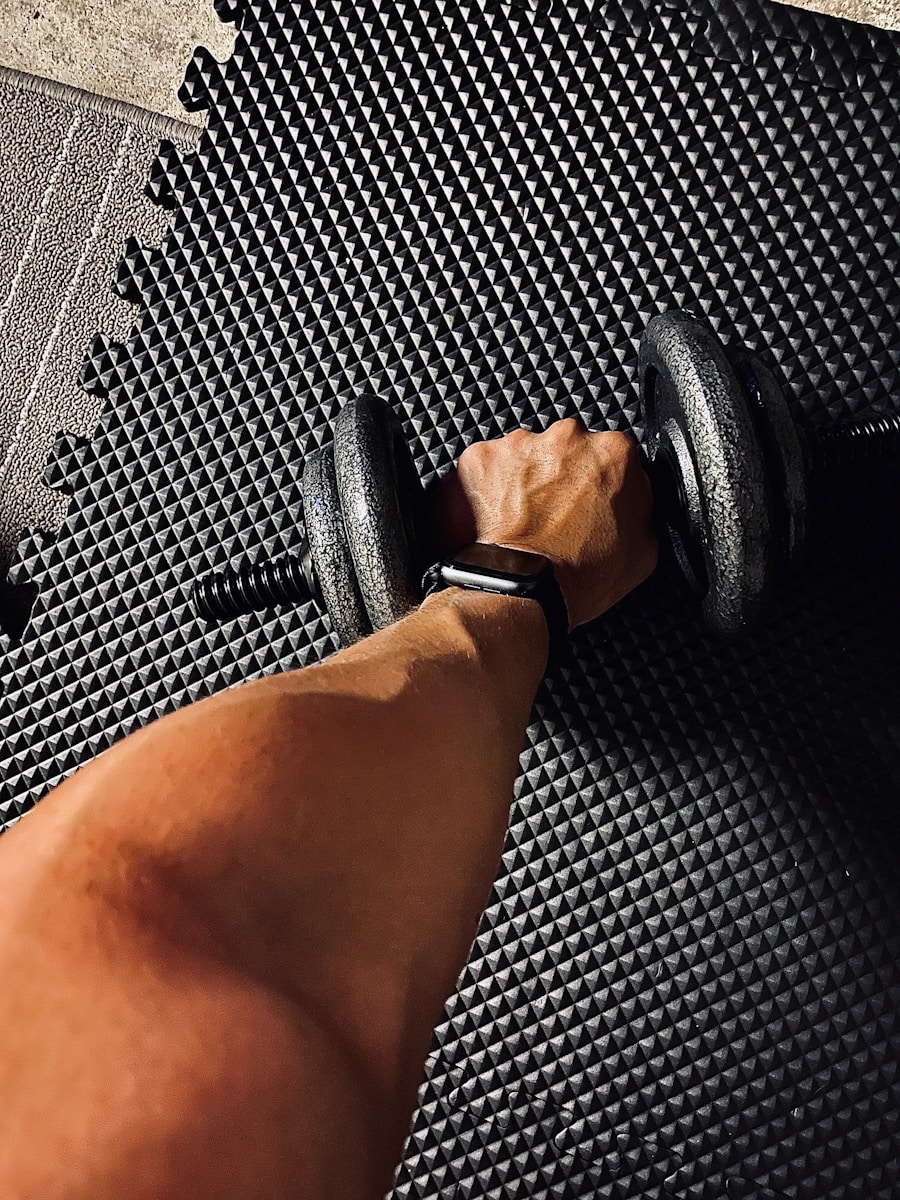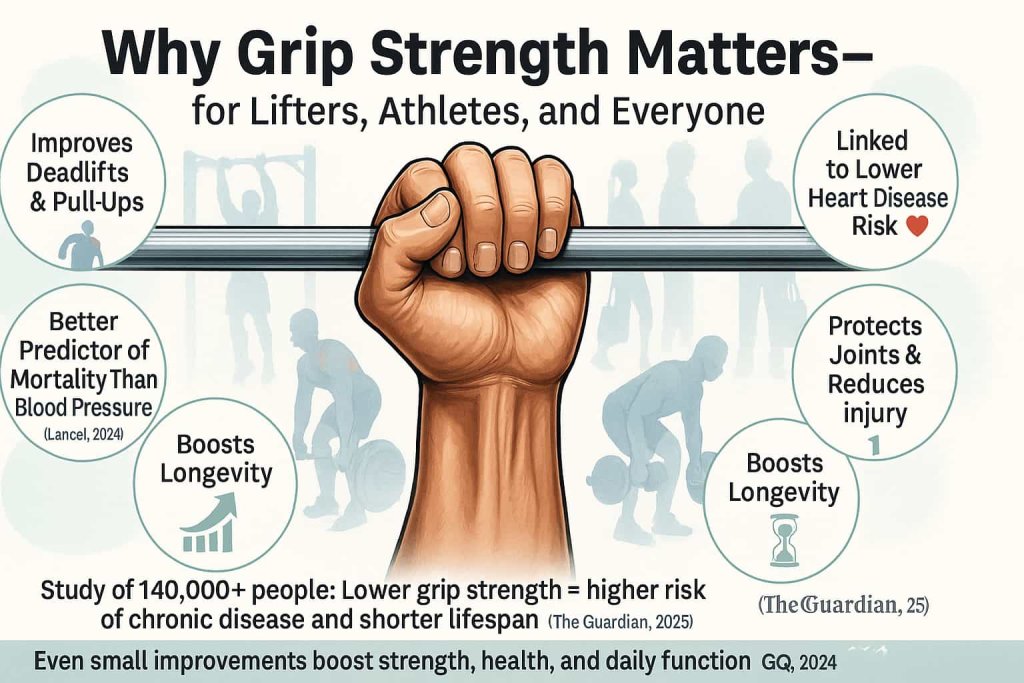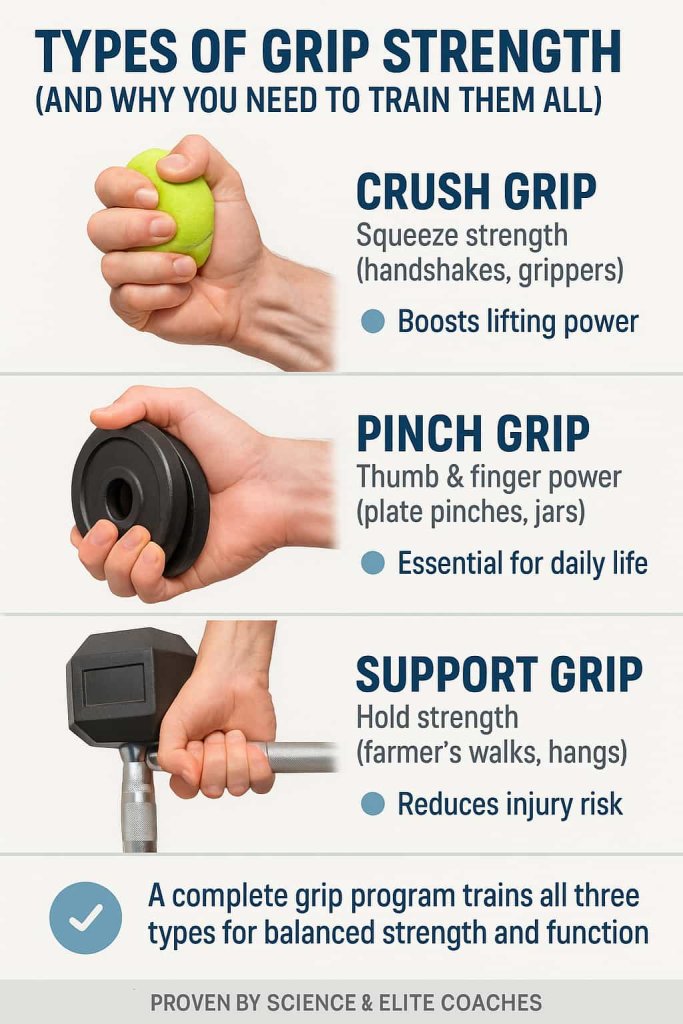Building a powerful grip does more than help you lift heavier weights—it boosts your total-body strength, supports healthy aging, and reduces your risk of injuries. In fact, research shows that grip strength is a leading indicator of overall health and longevity, not just athletic performance.

In this comprehensive guide, you’ll learn:
- Why grip training matters for everyone—not just athletes
- The different types of grip strength and how to train each one
- The best science-backed exercises for fast results
- Expert tips and an easy-to-follow program to maximize your gains
Ready to take your grip to the next level? Let’s dive in and discover the essential moves that will transform your strength, performance, and long-term health.
Why Grip Strength Matters—For Lifters, Athletes, and Everyone

Grip strength is more important than you think.
- It directly improves your performance in deadlifts, pull-ups, rows, and nearly every upper-body lift.
- Research shows that grip strength is linked to lower risks of heart disease, stroke, diabetes, and even overall mortality. A large global study in The Lancet (2024) found grip strength to be a better predictor of death and cardiovascular disease than blood pressure.
- Strong grip also means better joint protection and reduced injury risk, as your forearms, wrists, and hands are stabilized.
Longevity & Health:
According to The Guardian, studies of over 140,000 people show that lower grip strength is associated with a shorter lifespan and higher risk of chronic diseases (The Guardian, 2025).
A 2024 GQ report highlights that even small improvements in grip strength can lead to noticeable boosts in daily function and athletic performance (GQ, 2024).
If you want to get stronger, stay healthy, and age gracefully, grip strength training is essential.
Types of Grip Strength (And Why You Need to Train Them All)

There are three main types of grip strength, and each plays a unique role in training and real life:
- Crush Grip: The force generated when you squeeze something in your hand (e.g., grippers, tennis ball, handshake).
- Pinch Grip: Holding something between your thumb and fingers (e.g., plate pinches, opening jars).
- Support Grip: The ability to hold onto something for time (e.g., dead hangs, farmer’s walks).
A well-rounded grip program targets all three for full forearm, wrist, and hand development.
The 12 Best Grip-Strength Exercises (With Detailed Instructions & Science)
Grip strength is one of the best predictors of total body strength and functional fitness. Whether you want to lift heavier, improve sports performance, or maintain independence as you age, training your grip is essential. Research shows that stronger grip is linked to greater longevity, reduced risk of injury, and better quality of life (NIH, 2024). Below are the top grip-strength exercises—trainer-tested and science-backed—each with step-by-step guidance and pro tips.
1. Dead Hangs
- How to Do It:
Grab a pull-up bar with an overhand grip, arms fully extended, feet off the floor. Engage your core, keep shoulders away from your ears, and hang as long as you can.
- Benefits:
Builds support grip, decompresses the spine, and improves shoulder stability. - Trainer Tips:
Start with 20–30 seconds, add time as you get stronger. Try mixed or overhand grip for variation. - Science Insight:
Dead hangs are recommended by trainers and physical therapists to build foundational grip and shoulder health (The Guardian, 2025).
2. Farmer’s Walks
- How to Do It:
Hold a heavy dumbbell or kettlebell in each hand at your sides, stand tall, and walk for distance or time.
- Benefits:
Trains support grip, forearm strength, core stability, and posture. - Trainer Tips:
Use very heavy weights with perfect posture. Start with 20–40 meters per set, increase load or distance as you progress. - Variation:
Try the “suitcase carry” with weight in only one hand for extra oblique and grip challenge.
3. Plate Pinch Holds
- How to Do It:
Pinch two smooth-sided weight plates together between your fingers and thumb. Hold for time.
- Benefits:
Develops pinch grip, thumb strength, and fine motor control. - Trainer Tips:
Add more plates, use thicker or wider plates for extra difficulty. - Application:
Perfect for climbers, athletes, or anyone wanting to maximize hand strength.
4. Towel Grip Pull-Ups or Towel Wringing
- How to Do It (Pull-Ups):
Loop a towel over a pull-up bar, grab both ends, and perform pull-ups or simply hang.
- How to Do It (Wringing):
Wring out a wet towel repeatedly for reps.
- Benefits:
Dramatically increases grip and forearm demand, improves crush and pinch strength. - Trainer Tips:
Beginners can start with just hangs or assisted pull-ups. - Bonus:
Both methods build wrist and forearm endurance.
5. Wrist Curls & Reverse Wrist Curls
- How to Do It:
Sit on a bench, forearms resting on thighs. Palms up for wrist curls, down for reverse. Curl weights up and down using only wrists.
- Benefits:
Strengthens wrist flexors and extensors, reduces injury risk, and balances forearm development. - Trainer Tips:
Use light to moderate weights, focus on high reps and perfect control.
6. Wrist Roller
- How to Do It:
Attach a weight to a rope, roll up and down using a thick bar or dowel held at shoulder height.
- Benefits:
Works forearm flexors/extensors and builds endurance. - Trainer Tips:
Use heavier weights or roll for more sets as you improve. - Real-World Use:
Favored by strongmen and climbers for unmatched forearm burn.
7. Thick-Bar or Fat-Grip Lifts
- How to Do It:
Perform rows, curls, or deadlifts using a thick bar, Fat Gripz, or a towel-wrapped handle.
- Benefits:
Dramatically increases activation of grip and forearm muscles. - Trainer Tips:
Start lighter—thick handles are much harder than standard. - Science Note:
Fat grip training is proven to recruit more muscle fibers in the forearm and hand (NSCA, 2024).
8. Kettlebell Bottom-Up Press
- How to Do It:
Hold a kettlebell upside down (bottom-up) by the handle, press overhead.
- Benefits:
Trains grip, wrist, and shoulder stability. - Trainer Tips:
If the bell wobbles, your stabilizers are firing—focus on slow, controlled reps.
9. Hand Squeezes (Tennis Ball, Putty, or Grippers)
- How to Do It:
Squeeze a tennis ball, therapy putty, or hand gripper for timed holds or repetitions.
- Benefits:
Boosts crush grip, finger strength, and muscular endurance. - Trainer Tips:
Try for 10–20 reps or 30-second squeezes per set. - Science Insight:
Even simple at-home squeezing improves grip strength and function in athletes and seniors (VeryWell Health, 2024).
10. Rolling Thunder Lifts
- How to Do It:
Use a rotating, thick-handle grip (like IronMind’s Rolling Thunder) for single-arm deadlifts or static holds.
- Benefits:
Challenges rotational and support grip. - Trainer Tips:
Excellent for arm wrestlers, climbers, and serious grip athletes.
11. Hook Grip Holds
- How to Do It:
Use a hook grip (thumb under the fingers) while deadlifting or rowing, and hold at the top.
- Benefits:
Strengthens the thumb, improves bar security, and preps you for heavy Olympic lifts. - Trainer Tips:
Practice gradually—hook grip takes getting used to.
12. Deadlift Holds or Static Barbell Holds
- How to Do It:
Lift a heavy barbell, hold it at the top of the deadlift for max time.
- Benefits:
Simulates real-life grip needs, boosts support grip and endurance. - Trainer Tips:
Try mixed grip or double overhand for added challenge.
Rest at least 1–2 minutes between sets.
Science & Safety Tips for Grip Training
Recovery: Forearms and hands recover faster than larger muscles but still need rest.
Progress gradually: Overdoing grip work can lead to elbow or wrist pain. Increase volume slowly.
Mix up grip types: Train support, crush, pinch, and open-hand grip for balanced strength.
Real-World Examples & Trainer Tips
- Deadlifts: Stronger grip means less need for straps and better pulling performance.
- Pull-Ups: Dead hangs and towel pull-ups help you add reps and prevent “grip failure.”
- Sports: Climbers, wrestlers, and even golfers all benefit from pinch, crush, and support grip.
Pro Tips:
Always progress gradually (increase hold time or load). Don’t neglect wrist extensors—reverse wrist curls prevent muscle imbalances. If you feel pain (not fatigue), rest and adjust your grip variation.
How Often Should You Train Grip Strength?
- 2–3 times per week is ideal for most people, based on recent research (GQ, 2024).
- Rotate exercises to hit all grip types and prevent overuse.
- Sessions can be short—10–15 minutes is enough if you train with intensity.
Sample Weekly Grip Routine
| Day | Exercise | Sets & Reps |
|---|---|---|
| Monday | Dead Hangs, Farmer’s Walks | 3 x 30s, 3 x 30m |
| Wednesday | Plate Pinch Holds, Wrist Curls | 3 x max hold, 3 x 15 |
| Friday | Towel Pull-Ups, Hand Squeezes | 3 x max reps, 3 x 30 squeezes |
| Optional | Thick-Bar Holds, Bottom-Up Press | 2–3 sets, 5–10 reps/holds |
Frequently Asked Questions
How quickly will I see results?
Most people notice a stronger grip and improved lift control in just 3–6 weeks with regular training.
Can I train grip at home?
Yes! Tennis balls, towels, and even heavy grocery bags are effective tools for home grip workouts.
Do I need expensive equipment?
No—most grip exercises need only basic gym gear or home items.
Can I overtrain my grip?
If you only train crush grip (grippers) and ignore the rest, you can develop overuse injuries. Balance your training and take rest days as needed.
Health Benefits Beyond Lifting
- Strong grip is associated with lower mortality risk and greater independence in old age.
- Enhances daily activities—opening jars, carrying bags, or playing sports becomes easier.
- Reduces risk of wrist and elbow injuries by strengthening supporting muscles and tendons.
Conclusion
Training your grip is one of the fastest ways to upgrade your lifting performance and support your health for life.
Start with a few of these best grip-strength exercises, train consistently 2–3 times a week, and gradually increase the challenge. You’ll see (and feel) the results—both in the gym and in everyday life.
